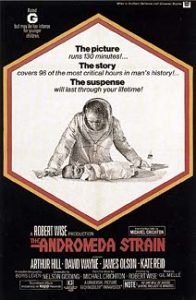 (1971, rated G “but may be too intense for younger children”) Arthur Hill (Jeremy Stone), James Olson (Mark Hall), Kate Reid (Ruth Leavitt), David Wayne (Charles Dutton), Paula Kelly (Karen Anson), Ramon Bieri (Maj. Manchek), Kermit Merdock (Dr. Robertson), Eric Christmas (Sen. Phillips), Ken Swofford (Toby). Music: Gil Mellé. Screenplay: Nelson Gidding (based on the novel by Michael Crichton). Director: Robert Wise. 130 minutes.
(1971, rated G “but may be too intense for younger children”) Arthur Hill (Jeremy Stone), James Olson (Mark Hall), Kate Reid (Ruth Leavitt), David Wayne (Charles Dutton), Paula Kelly (Karen Anson), Ramon Bieri (Maj. Manchek), Kermit Merdock (Dr. Robertson), Eric Christmas (Sen. Phillips), Ken Swofford (Toby). Music: Gil Mellé. Screenplay: Nelson Gidding (based on the novel by Michael Crichton). Director: Robert Wise. 130 minutes.
Tags: Sci-Fi, Suspense, Alien Contact
Notable: All of the tech that you see was directly from then-current-day laboratories, showing we’re further ahead than we all thought before; actor Arthur Hill really used the mechanical hands himself; James Olson, usually cast as a “bad guy,” gets to be the hero for a change.
Rating: ★★★★★
A NASA probe, Scoop VII, has crash-landed near the tiny town of Piedmont, New Mexico (Population: 68). An Army team of two sent in to find and retrieve the satellite finds a town full of dead bodies, and they too are swiftly killed through no identifiable means from a distance. A biological agent is suspected, creating a “Wildfire Alert” – an immediate priority to scramble a specific team of scientists to gather at a huge underground facility specifically created to combat a biological emergency of this type. Jeremy Stone (Hill) petitioned the government to create it a few years earlier, citing a failure to avoid contamination at the NASA lunar lab; now, the facility, and the scientists who have been called, are about to be put to the test.
Chrichton’s novel, published in 1969, catapulted him into literary stardom almost overnight, and the plot of the film – kept faithful to the book, nearly to the letter – shows why. Some idiot decided it would be a great idea to gut the book, fill up time with stupidity and irrelevant plot contrivances, and convince A&E to make a mini-series of it in 2008. This is further proof that no one ever went broke underestimating the taste of the American viewing audience. Even on Amazon, the largest number of reviews gave the remake one star, many of them complaining that they couldn’t award zero stars. This version, the original 1971 edition, is the version you want to watch; it still stands up after over 40 years.
Crichton was an M.D. as well as a writer, and his knowledge of medical science helped him to create an astonishing concept that still gives me the willies. Add in a director of Wise’s talent (The Day the Earth Stood Still (1951) and The Haunting (1963), to name two), plus a $6.5 million budget, and you get this exceptional result. Visuals and environments were envisioned and created by Douglas Trumbull (2001: A Space Odyssey (1968), Brainstorm (1983)) and Albert Whitlock, the visionary creator of effects for Alfred Hitchcock.
The film gets your attention right from the start with the strangely attractive yet grating electronic soundscape created by composer Gil Millé. No small surprise for the man who created his own electronic instruments and composed a number of fascinating soundtracks for television films like A Cold Night’s Death (1972), The Questor Tapes (1974), and the eerie sounds of the opening credits for Rod Serling’s Night Gallery. Within minutes, the plot begins to race, and the pace rarely slows to more than a modest jog, frequently ramping up to full-bore cheetah speeds. By the time you get to the climactic ending, you’re pretty well out of breath, and rightly so.
I had a chance to interview England-born Canadian actress Kate Ried (Leavitt) in 1976, to talk about the film. She said first that “it was like performing in a foreign language. I kept a dictionary off-camera the whole time.” She was fluent in English, but the scientific terms and usage was a real challenge. It was also she who helped to create a whole series of “business” regarding smoking. She was a smoker, in real life, particularly when she was nervous. She asked director Wise if she could smoke during an early scene, despite the No Smoking sign in the laboratory set. Wise thought about it and agreed, creating several great lines and other moments in the film, some of it improvised, all of it good. I got to spend a good hour with the lady, and she was a complete delight. She passed in 1993.
That very point — the scientific veracity of the script, and the sets to go with it — are what make this version the best of all possible versions. There’s never any sense in remaking a movie when the original is still the best version possible. This is a harangue that you will hear from me often, so prepare yourself. Meanwhile, give yourself a treat and watch a “hard-science” sci-fi film that’s as exciting now as it was when I saw it in the theater with my Dad. He was a doctor himself, and he found little to argue with in the film. He’s a stickler for accuracy in any show using science as a basis, so when this film got his stamp of approval, I felt quite vindicated. He didn’t even gripe about the cost of the movie tickets — a whopping $2.50 each, about that time…
An amusing aside. In the film, you’ll notice a particular, oddly-made rectangular key that becomes quite a plot point. As part of the promotion of the film, an identical key was provided, on a neck chain, for one of the ushers to wear.
